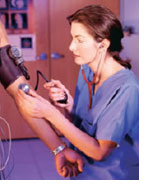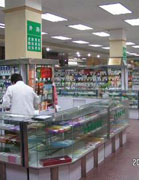| |
|
 |
 |
| Life Sciences & Health Care (including pharmaceuticals, biotechnology & medical devices) |
 |
 |
 |
In today’s life sciences industry, scientific and technological frontiers are expanding at unprecedented rates—even as economic and financial pressures shrink profit margins, intensify competition and constrain the funds available for investment. Consequently, health care players throughout the industry must confront difficult choices. The players—the developers, manufacturers, and distributors of health care products as well as the payers and the providers that deliver health care services—that take aggressive steps now will find themselves better positioned for survival and ultimately success in the years ahead.
Siegle, Hu & Partner’s Life Sciences Practice
Our Pharmaceuticals & Health Care practice has specific capabilities tailored to address these important issues, including: |
- Mergers & acquisitions, especially transcontinental transactions
- R&D cooperations & licencing
- Customer strategy development and implementation
- Sales force strategy and effectiveness
- Sourcing and outsourcing
- Supply chain management and performance improvement
- Diversification into services
|
SHP consultants have an established reputation for dealing with top line growth issues, including product commercialization and strategydevelopment, as well as operational and cost-side issues. Our consultant experience spans pharmaceuticals, biotechnology, medical diagnostics, medical devices, medical suppliers and medical distributors.
Market insights: Examples from our health care practice
China’s Pharmaceutical Market offers both, Opportunities and Challenges
 China, in terms of both its healthcare system and pharmaceutical market, is a nation of contradiction. As the world's most populous country, and one in possession of the fastest growing major economy in the world, the nation offers a vast array of opportunities for overseas investors, complemented by a massive potential workforce and consumer base. The government has promised large-scale investment in order to improve healthcare.
However, several factors inherent in the nation's make up undermine many of these opportunities.
China remains a very poor GDP country and pharmaceutical expenditure per capita is similar to that in Pakistan or India. Increasingly China is becoming a "2 track" country. While there are some very high quality hospitals and clinics in the big cities, in rural areas facilities are badly-equipped, drugs are in short supply and trained staff are lacking.
But that's just part of the story. The role of traditional Chinese medicine in limiting the growtgh of western medicine, continuing issues about intellectual property protection, the dominance of "copycat" drugs, a growing AIDS problem, antibiotic resistance, the expansion of Chinese R&D and downward pressure in drug pricing are all part of the mix.
POPULATION BASE |
China is a large and fast growing market, but it is far from being a rich one. Of the population of 1.28 billion, around 870 million live in poor rural areas with little healthcare infrastructure, and have no money to pay for treatments in expensive county level hospitals. The vast majority of the Chinese population, therefore, has severely limited access to healthcare, especially that provided by expensive imported drugs. The government has plans to recreate some form of the defunct rural health insurance scheme, but it is difficult to see how this will generate the cash to provide anything other than the most basic level of care.
OTC DRUGS
The fastest growing Asian OTC market is China's, growing at a considerable rate each year, and it is anticipated that it will continue to flourish over the coming years. In 2000, the SDA implemented a system to classify and separate prescription and OTC preparations. As ever in China, there are differing attitudes to opportunities for OTC medicines in different parts of the country. The system, expected to be fully functional in 2005, will shift a greater proportion of drug costs from the state to the consumer, especially with regard to more minor ailments. Interestingly, AstraZeneca released its first OTC drug, their antacid Losec (Omeo Prazole) in China in April 2005.
GENERIC DRUGS
The Chinese market is dominated by generic drugs. The local manufacturing sector specializes in the production of off-patent generics, such as antibiotics, or copied drugs. It is estimated that around 97% of drugs produced by domestic firms are generics, although many will be counterfeit.
R&D
China is keen to expand its domestic research & development sector and there are benefits for western companies. These include exemptions from import duties and other custom taxes that foreign companies can benefit from if they undertake R&D in the country. Foreign companies involved in joint ventures are likely to benefit from the exemptions to a much greater extent than those who are not. Further criteria of the initiative gives a clear indication of this sentiment, with similar rewards on offer for the production and development of new products with Chinese hospitals and pharmaceutical institutions and exemption from further business taxes available to foreign companies transferring technology to Chinese partners.
INTELLECTUAL PROPERTY
The issue of intellectual property rights remains a major problem for overseas companies wishing to supply pharmaceuticals to China. While there is an initially impressive array of legislation, enforcement of regulations is often difficult. The system initially appears in line with international norms, but in practice this is not the case: the infringement of patents is a new concept in China, and those accused of doing so will defend their case vigorously. The Chinese legal system is also poorly equipped to deal with complicated technical issues; judgements are often made on the basis of 'seniority' or with political considerations to the fore. When penalties are issued, they are reportedly often to be low, and are difficult to enforce. In short, China has most of the necessary legal machinery, but time and effort is required in order to make it work effectively.
Increased Urbanisation
More and more Chinese are moving off the land and into the cities, a trend which started in the early 1980s at the start of the economic reforms. This is happening at astonishing rates and there are no signs of it slowing down. In 1999, for example, urban population accounted for 30 per cent of the population and increased to 35 per cent only one year later. What this means for the OTC market is an increase in consumer access to OTC product advertising and the retail outlets which carry these goods
AGEING POPULATION
The country is also ageing quickly at a projected rate of three per cent annually. 2000 census data shows that the 130 million people aged 60 and older accounted for 10 per cent of the total population. This is due to advances in public health care, better nutrition and demographic changes owing to family planning. The need for daily health care products will increase as the country gets older.
MORE DRUGSTORES
According to Ministry of Health (MOH) figures, there are currently 120,000 retail pharmacies in China. MOH projects the number of retail pharmacies to eventually reach 300,000. Chinese retail pharmacies are State-owned, though more and more are being managed by private companies which receive a portion of profits after the State has reaped its share. In some larger municipalities, new retail pharmacy licences have been curtailed recently, but existing pharmacies are allowed to open additional branches based on their old licences. |
CONSUMER SOPHISTICATION |
More city dwellers with more choices leads to enhancements in advertising strategies. While many foreign participants in the Chinese market rely heavily on costly television and newspaper advertisements, the OTC sector has traditionally used more cost-effective maneuvers to attract customers. These include use of the retail pharmacy floor space for promo boards and specially trained staff to introduce and educate customers to a product's safety and efficacy. This encourages enhanced customer sophistication and demand for choice, which normally leads them to choose sino-foreign or foreign goods which they feel are superior to their comparable domestic alternatives.
REGISTRATION |
Both prescription and non-prescription drugs are heavily regulated in China and can be subjected to the scrutiny of either the MOH or the State Drug Administration (SDA). Registration is often a major hurdle to overcome in getting one's products on a pharmacy's shelf. How long the application process takes can depend on the kind of non-prescription drug put forward for approval. SDA approval for non-prescription drugs takes around 90 working days, whereas MOH approval may take up to 9 months. Application dossiers may include a number of documents such as efficacy reports, licenses, foreign approvals, specifications and formulations, as well as guarantees and general corporate information. The process may be stalled if the reviewing committee seeks additional information or clarifications. There may also be local approvals required by the State Bureau of Quality Supervision, Inspection and Quarantine.
However the often-complex registration process is being streamlined at the central level as increases in State spending on health care skyrocket. The Government hopes to decrease its annual spending on health care to around five per cent of projected GDP with drug care costs accounting for 11-13 per cent of this figure by 2010. An easier registration process will mean more OTC medicines becoming available. With greater consumer choice in remedies, the State saves money which would have been used to pay for medicines which before were prescribed by doctors and reimbursed with public funds.
DISTRIBUTION
 Foreigners have historically been precluded from participation in distribution networks in China. However, following WTO accession, these barriers have begun to weaken. Pharmaceuticals however, as regulated by the SDA, continue to have separate and often confusing rules regarding their distribution. To get into hospitals and retail outlets, pharmaceutical products must be distributed through specially licensed local distributors. These networks are highly regionalised, and companies have to negotiate and conclude distribution deals with several unconnected distributors. Distribution agreements are not exclusive so these companies do not promote the products they carry. In order to get distributors to carry larger quantities of their brands, drug companies are forced to either lead with products with profit margins attractive to distributors or spend more money on advertising to create a greater overall market demand.
MOH is not happy with this system, no doubt due to State pressure to increase OTC products to save on health care costs, and has forced the distribution network to reform itself. One way it has attacked the problem is by reducing the number of distributors it licenses to carry drugs. In 1997, there were over 17,000 distributors, but the number has now been cut down to about 6,000. The MOH goal is to develop around 50 large and interconnected distribution groups that could handle about 70 per cent of total pharmaceutical (prescription and non-prescription) sales. This is supposed to occur within the next five years. |
PRICING
The price of a foreign-produced OTC product is much higher than a domestic alternative due to pricing factors such as import tax, value-added tax, higher foreign production costs and margins tacked on by distributors and retailers. A foreign headache reliever, for example, may cost RMB12 (€ 1.5), whereas its domestically produced counterpart may cost RMB5 (€ 0.625). A similar product manufactured in China by a foreign or sino-foreign enterprise may cost RMB9 (€ 1.125). Drugs are also subject to price controls because they are considered 'special commodities'. In 1997 drug pricing authority was turned over to the State Development Planning Commission (SDP), which in 1998 issued regulations on price and profit control. The authority now bases drug pricing on the following criteria: |
|
This new pricing structure resulted in manufacturers having the added cost of establishing pricing departments to deal with national and even local pricing regulations. Local pricing authorities were established by the SDP, which has resulted in considerable price differences on the same product in different areas of the country. In some cases, price controls have resulted in lower cost of products manufactured locally.
REIMBURSEMENT LIST |
China maintains a list of drugs which are included in the state health care reimbursement system. If a product is on 'the list', then the product is free. If not, then consumers must pay for it themselves. Getting on the list is an often lengthy and obscure process. It is administered by both national and local authorities which have the power to include or exclude products. When reviewing a product for inclusion, the authorities consider such factors as cost, efficacy, ease of use, safety, availability and balance between western and traditional therapies. The national list contains over 1,000 products and these are nearly all included on local lists. Few imported drugs make the list. Shanghai's list, for example, contains 885 drugs, only four per cent of which are imports.
INTELLECTUAL PROPERTY |
As stated above, there are about 5,000 pharmaceutical products currently on the Chinese market. Traditional Chinese medicines account for about 2,000 of these. Some experts estimate that of the remaining 3,000, 99 per cent are copies of foreign products (as are 90 per cent of China's biotech products). The US pharmaceutical industry estimates to have lost between 10-15 per cent of its expected earnings in China due to counterfeit products. Lost profits are one side of the counterfeiting problem, but more serious are the numerous cases of fakes causing illness or death. They are often manufactured in backyard factories operating well below hygienic standards. |
| |
 TOP TOP |
| |
|

